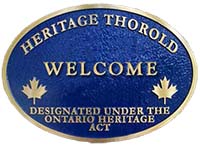Lock 25 – 2nd Welland Canal
Lock 25, located in the Battle of Beaverdams Park in downtown Thorold, is one of the 27 stone locks of the 2nd Welland Canal, which were constructed between 1841 and 1845 to replace the 40 inferior wooden locks of the 1st Canal. Its role, of historic significance not only for Niagara Region but the entire Great Lakes waterway system, was facilitating marine travel between Lakes Ontario and Erie.
Even after the bulk of marine traffic was diverted to the 3rd Canal after its construction in the 1870s and 80s, the former canal, including Lock 25, remained an active and iconic part of the townscape of Thorold, still serving marine traffic until World War I, and also providing power for local industries until the late 1940s.
After having been filled in during the late 1950s and 60s, like all the 2nd Canal locks which flowed through downtown Thorold, Lock 25 was partially excavated in 1976 when the Battle of Beaverdams Park was opened.
Along with 16 other locks of the 2nd Welland Canal, Lock 25 was constructed from limestone quarried locally, at what is now Walker’s Quarry, and which in the early 1840s was opened by Brown & Zimmerman expressly for the purpose of procuring stone for the 2nd Canal. Slightly larger than the original wooden locks, it measured 46 meters in length, 8 meters in width, and had a minimum depth of 3 meters. Today, only the finished capstones, including the flared gate ends and the original wrought-iron gate hinge hardware at one of them, are exposed, while the remainder of the lock lies below the surface. The capstones serve as seating in front of the bandshell stage in the Battle of Beaverdams Park.
Architecturally, the lock’s value lies in its form, craftsmanship, and general physical attributes which demonstrate its engineering and functional design, as well as its status as the only 2nd Welland Canal mountain lock in Thorold which is visible today.
Its historical and associative value lies in the role it played in improving and standardizing commercial and industrial transportation infrastructure, as well as its proximity to locks of the 1st Canal and its close association with important early Thorold citizens and businessmen like George Keefer, John Brown, and John Battle.
The Lock’s important contextual value lies in its association with Thorold’s 2nd Canal lands which were completely buried in the mid-20th century. Evidence of the presence of this waterway is found in the swale-like topography of central Thorold. The lock is also located within a 500-meter radius of numerous designated and non-designated heritage properties, sites, and memorials.
Lock 25 is part of the built heritage and cultural landscape of downtown Thorold, as a reminder of the various Welland Canals’ impact on the historic character of the community. It demonstrates how industrial heritage can be revitalized and incorporated into the cultural heritage landscape. As such it fulfills the goal of establishing a link to the past (place) that can serve to support contemporary aspirations and ideals (identity).
